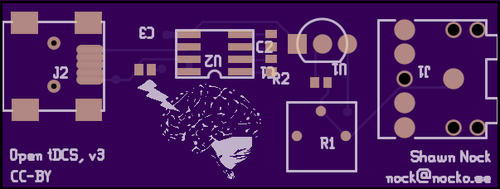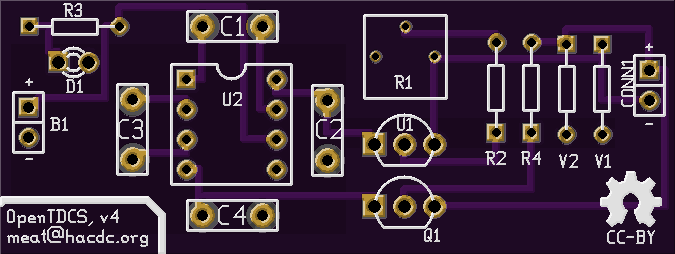TDCS: Difference between revisions
From HacDC Wiki
m (→Version 4) |
mNo edit summary |
||
| (2 intermediate revisions by the same user not shown) | |||
| Line 2: | Line 2: | ||
= Introduction = | = Introduction = | ||
[http://en.wikipedia.org/wiki/TDCS tDCS] is a method of passing a (very) small direct current through the brain to elicit changes in neuronal plasticity. The current passes from the | [http://en.wikipedia.org/wiki/TDCS tDCS] is a method of passing a (very) small direct current through the brain to elicit changes in neuronal plasticity. The current passes from the anode electrode through the scalp, cranial vault and parts of the brain into the cathode electrode (for anodal stimulation). | ||
=Effects= | =Effects= | ||
| Line 45: | Line 45: | ||
== Version 3 == | == Version 3 == | ||
[[File:opentdcs-v3.png]] | [[File:opentdcs-v3.png]] | ||
Links: | Links: | ||
*[https://github.com/nocko/tdcs/blob/v3/bom.txt Bill of Materials] | *[https://github.com/nocko/tdcs/blob/v3/bom.txt Bill of Materials] | ||
| Line 63: | Line 64: | ||
Advantages: | Advantages: | ||
* Inexpensive / Simple | * Inexpensive / Simple | ||
* | * 2mA available via 9V battery with most (sub-15kOhm) electrode+head configurations. | ||
Disadvantages: | Disadvantages: | ||
Latest revision as of 16:41, 8 November 2012
Transcranial Direct-Current Stimulation
Introduction
tDCS is a method of passing a (very) small direct current through the brain to elicit changes in neuronal plasticity. The current passes from the anode electrode through the scalp, cranial vault and parts of the brain into the cathode electrode (for anodal stimulation).
Effects
Hackers are primarily interested in tDCS because (in some configurations) it seems to increase learning rates. Other possible uses for DIY tDCS include:
- Relief of some types of neuropathic pain by repeated anodal stimulation of the Motor Cortex
- Management of some types of Depression with anodal stimulation of the Dorsolateral Prefrontal Cortex (DLPFC)
Safety
Current Status
Several designs for easily-built open source TDCS have been produced under the name OpenTDCS. None are currently ready for wide-spread use, but are available for reference and experimentation. The recommended version for testing is v4 (below), prototype PCBs have returned from fab and await assembly at the November 8th 2012 Meatup.
Devices
Version 1
Links:
The v1 model was a modification of the GoFlow Schematic. It differs in that it has a potentiameter to adjust the current limiter instead of a 4-way switch. The power is supplied via a barrel connector, but the device should never be powered from a wall socket when connected also to a human being
Advantages:
- Low cost
- Few parts
Disadvantages:
- Primitive.
- Cannot provide 2mA without modification.
- No Electrostatic Discharge (ESD) protection
- No fail-safe if the LM334Z current limiting IC were to fail.
Version 2
The v2 was a testing platform for a microcontroller controlled tDCS stimulator. USB power was not a good fit due to power supply isolation issues. No prototypes were built, the design is flawed and not recommended for any use.
Version 3
Links:
The v3 was designed to test the floating capacitor switching supply concept used in the v2. It was abandoned when the isolation issues in v2 became apparent. The design will probably work safely if the USB power is provided by a laptop running on battery power, but construction or use of the v3 design is not recommended
Version 4
Links:
The v4 is designed to drive higher impedance electrodes in addition to the usual sponge+saline electrodes by using the LT1026 charge pump controller to produce +18V to -18V split source from a 9V battery. It uses the LM334Z IC for fine current limiting control and a JFET as a gross 5mA limiter in case of LM334Z failure. ESD protection comes from two varistors.
Advantages:
- Inexpensive / Simple
- 2mA available via 9V battery with most (sub-15kOhm) electrode+head configurations.
Disadvantages:
- Limited visual feedback to user (on/off only)
- Current needs to be calibrated with external ammeter



